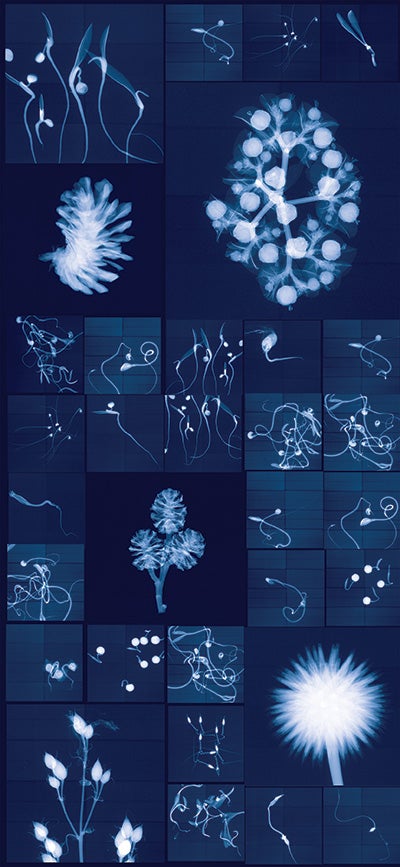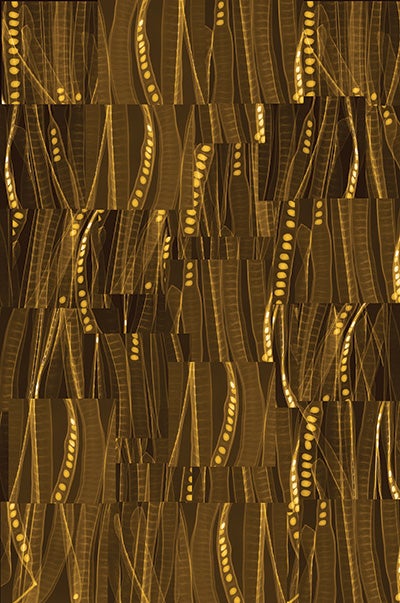Seeds of Life
Artist Dornith Doherty finds beauty and optimism in the layers of catastrophe and preservation.

Digital chromogenic lenticular photograph, 79 x 36 inches
Digital collage made from X-rays captured at the Millennium
Seed Bank (England)
Dornith Doherty ’80 has spent much of the last 15 years of her career photographing the microscopic — pollution particles that have torn through bird feathers, fern spores that can travel thousands of miles in the wind and hundreds of meticulously preserved seeds from around the world.
Her art focuses on the intersection between climate change, ecology and human endeavor; the seeds, feathers and spores are what she calls visual metaphors for the optimism driving research and preservation in the face of potential catastrophe. Her most renowned series, “Archiving Eden,” presents a photographic documentary of seed banks, as well as artistic interpretations of the seeds preserved within them.
“I think it’s a profoundly important subject matter,” Doherty says. It’s one that presents endless possibilities, too.
“So much of what we’re hearing is that [climate change] is inevitable, that it’s all on the individual and that the problem is too big — so people get discouraged.”
Doherty first became fascinated with seed banks in 2008 after reading about the Svalbard Global Seed Vault, a scientific endeavor to stockpile important crop seeds in case species start to go extinct due to climate change, diseases, war or other catastrophes. Scientists from countries such as Ireland, Syria, Colombia, Mexico and Japan have deposited seed samples in the vault, which is buried under layers of permafrost, ensuring that the seeds stay in a frozen state — even during a power outage. Today, there are over 1 million distinct crop samples, representing tens of thousands of years of agricultural history, preserved in the remote Svalbard vault.
“I was fascinated by the idea of [seed banks] being utopian and dystopian,” Doherty says. “There’s a need to establish this fortified vault on an inaccessible island near the North Pole. But on the other hand, it’s a collaborative project from nations around the world. I was really inspired by that kernel of hope embedded in the whole concept of the seed bank.”
But for the University of North Texas studio art distinguished research professor, the project initially started much closer to home. In 2008, at the Lady Bird Johnson Wildflower Center in Austin, Texas, she captured the intricate labor required to count, dry and package seeds to send off to other research institutes and banks. A connection at the Wildflower Center led her to the National Laboratory for Genetic Resources Preservation in Fort Collins, Colorado. With a stroke of luck, Doherty says, the scientists allowed her to come into the lab and take documentary photographs.
The laboratory building itself was an austere concrete bunker. But inside, scientists were handling seeds that contained the potential for life. In particular, the use of X-rays to analyze the seeds piqued Doherty’s interest. “I was very interested in the lab space and technology that was required to place seeds in a state of suspended animation required for seed banking,” she says. “I thought it was really visually and metaphorically interesting to peer inside this seed and see the interior of this spark of life that they’re trying to make last for more than 200 years.”

Since then, Doherty has traveled to 20 different seed banks on five continents to produce documentary photographs and artistic interpretations of their holdings. Many of the artworks in “Archiving Eden” are composite images of those seed X-rays from around the world. In one artwork, dozens of X-rays of starburstlike seed heads of an Australian bush are combined and colored indigo — a color that itself evokes metaphors of the Columbian exchange, when global trade circulated seeds and plants between continents for the first time.
The scientific process that Doherty captures in her photography is likely inaccessible to most Americans, or the general public, in any of the countries she’s visited for the project. Seed banks, like a lab, require a carefully calibrated environment so that seed samples don’t get contaminated or damaged; in many countries, they are also a matter of national security and economic interest.
However, “I have not had anybody say, ‘no,’” Doherty says, of the scientists who have let her into high-security labs. “It’s a small group of people working globally on this project.” Though the COVID-19 pandemic has paused her travels, she hopes to resume soon. On her list of possible destinations: a seed bank in the Philippines that has preserved varieties of rice, one in Africa focused on wheat, and one in Peru, where potato specimens are being preserved. “I think it’s such an important endeavor — through saving seeds, we’re trying to save the human race itself, because we’re so dependent on plants,” Doherty says. “So [the project] just keeps going. I don’t have plans to end it.” — Amal Ahmed
Top image: Dornith Doherty. “Kangaroo Grass”
Archival pigment, 33 x 49 inches
Digital collage made from X-rays captured at PlantBank (Australia)
